Metapopulation Structure of Two Species of Pikeworm (Triaenophorus, Cestoda) Parasitizing the Postglacial Fish Community in an Oligotrophic Lake
Abstract
:Simple Summary
Abstract
1. Introduction
2. Materials and Methods
2.1. Sample Collection
2.2. Parasitological Analysis
2.3. Statistical Analysis
3. Results
3.1. Prevalence and Intensity of Fish Infestation with Triaenophorus spp.
3.1.1. Intermediate Hosts Infected by T. crassus
3.1.2. Intermediate Hosts Infected by T. nodulosus
3.1.3. Distribution of T. crassus and T. nodulosus Plerocercoids
3.1.4. Definitive Host
3.2. The Relationship between Wet Weight of Cestodes and Their Hosts
3.2.1. Intermediate Hosts Infected by T. crassus
3.2.2. Intermediate Hosts Infected by T. nodulosus
3.2.3. Definitive Host
3.3. Clinical Signs of Infestation and Localization of T. nodulosus and T. crassus in Fish
4. Discussion
5. Conclusions
Supplementary Materials
Author Contributions
Funding
Institutional Review Board Statement
Informed Consent Statement
Data Availability Statement
Conflicts of Interest
References
- Knudsen, R.; Rikardsen, A.H.; Dempson, J.B.; BjØrn, P.A.; Finstad, B.; Holm, M.; Amundsen, P.-A. Trophically transmitted parasites in wild Atlantic salmon post-smolts from Norwegian fjords. J. Fish Biol. 2005, 66, 758–772. [Google Scholar] [CrossRef]
- Knudsen, R.; Amundsen, P.A.; Nilsen, R.; Kristoffersen, R.; Klemetsen, A. Food borne parasites as indicators of trophic segregation between Arctic charr and brown trout. Environ. Biol. Fishes 2008, 83, 107–116. [Google Scholar] [CrossRef]
- Busarova, O.; Markevich, G.; Esin, E. Trophic differentiation of the nosed charr Salvelinus schmidti Viktorovsky, 1978 in Lake Kronotskoe (Kamchatka). Russ. J. Mar. Biol. 2017, 43, 57–64. [Google Scholar] [CrossRef]
- Bonato, K.O.; Silva, P.C.; Malabarba, L.R. Unrevealing parasitic trophic interactions—A molecular approach for fluid-feeding fishes. Front. Ecol. Evol. 2018, 6, 22. [Google Scholar] [CrossRef]
- Vlasenko, P.G.; Sokolov, S.G.; Ieshko, E.P.; Frolov, E.V.; Kalmykov, A.P.; Parshukov, A.N.; Chugunova, Y.K.; Kashinskaya, E.N.; Shokurova, A.V.; Bochkarev, N.A.; et al. A re-evaluation of conflicting taxonomic structures of Eurasian Triaenophorus spp. (Cestoda, Bothriocephalidea: Triaenophoridae) based on partial cox1 mtDNA and 28S rRNA gene sequences. Can. J. Zool. 2022, 100, 323–333. [Google Scholar] [CrossRef]
- Kuperman, B.I. Tapeworms of the Genus Triaenophorus, Parasites of Fish. Experimental Systematics, Ecology; Nauka: Leningrad, Russia, 1973; p. 208. (In Russian) [Google Scholar]
- Kuchta, R.; Vlckova, R.; Poddubnaya, L.G.; Gustinelli, A.; Dzika, E.; Scholz, T. Invalidity of three Palaearctic species of Triaenophorus tapeworms (Cestoda: Pseudophyllidea): Evidence from morphometric analysis of scolex hooks. Folia Parasitol. 2007, 54, 34–42. [Google Scholar] [CrossRef] [PubMed]
- Titova, S.D. Parasites of fish from Teletskoye Lake. Tr. Probl. I Temat. Soveshhanij Zin. Vii Soveshhanie Po Parazitol. Probl. 1954, 4, 79–84. (In Russian) [Google Scholar]
- Kashinskaya, E.N.; Vlasenko, P.G.; Bochkarev, N.A.; Andree, K.B.; Solovyev, M.M. Feeding habits shape infection levels by plerocercoids of the tapeworm Triaenophorus crassus in muscle of a sympatric pair of whitefish in an oligotrophic lake. J. Helminthol. 2021, 95, e8. [Google Scholar] [CrossRef]
- Kuperman, B.I. New species of the genus Triaenophorus Rud. (Cestoda, Pseudophyllidea). Parazitologiya 1968, 2, 495–501. (In Russian) [Google Scholar]
- Bush, A.O.; Lafferty, K.D.; Lotz, J.M.; Shostak, A.W. Parasitology meets ecology on its own terms: Margolis et al. Revisited. J. Parasitol. Res. 1997, 83, 575–583. [Google Scholar] [CrossRef]
- Hammer, Ø.; Harper, D.A.T.; Ryan, P.D. PAST: Paleontological statistics software package for education and data analysis. Palaeontol. Electron. 2001, 4, 1–9. Available online: http://palaeo-electronica.org/2001_1/past/issue1_01.html (accessed on 1 April 2023).
- Wickham, H. ggplot2: Elegant Graphics for Data Analysis, 2nd ed.; Springer: New York, NY, USA, 2016; 368p. [Google Scholar] [CrossRef]
- Reiczigel, J.; Marozzi, M.; Fábián, I.; Rózsa, L. Biostatistics for parasitologists—A primer to quantitative parasitology. Trends Parasitol. 2019, 35, 277–281. [Google Scholar] [CrossRef]
- Wayland, M.T.; Chubb, J.C. A new R package and web application for detecting bilateral asymmetry in parasitic infections. Folia Parasitol. 2016, 63, 1–5. [Google Scholar] [CrossRef] [PubMed]
- Bondarenko, A.V. (Ed.) Red Book of the Altai Republic. Animals, 3rd ed.; GAGU: Gorno-Altaisk, Russia, 2017; 368p. (In Russian) [Google Scholar]
- Valtonen, E.T.; Rintamäki, P.; Lappalainen, M. Triaenophorus nodulosus and T. crassus in fish from Northern Finland. Folia Parasitol. 1989, 36, 351–370. [Google Scholar]
- Andersen, K.I.; Valtonen, E.T. Segregation and co-occurrence of larval cestodes in freshwater fishes in the Bothnian Bay, Finland. Parasitology 1992, 104, 161–168. [Google Scholar] [CrossRef]
- Rusinek, O.T. Fish Parasites of Lake Baikal (Fauna, Communities, Zoogeography and Historical Background); KMK Scientific Press Ltd.: Moscow, Russia, 2007; p. 571. (In Russian) [Google Scholar]
- Dugarov, Z.N.; Pronin, N.M.; Batueva, M.D.; Burdukovskaya, T.G.; Matveev, A.N.; Pronina, S.V.; Sondueva, L.D. Fauna of parasites of burbot Lota lota (L.) (Gadiformes: Lotidae) from reservoirs of Baikal Rift Zone. Inland Water Biol. 2016, 9, 341–349. [Google Scholar] [CrossRef]
- Bauer, O.N. Ecology of parasites of freshwater fish (Relationship of the parasite with environment). Izv. GosNIORH 1959, 49, 5–206. (In Russian) [Google Scholar]
- Protasova, E.N. Cestodes of Fish—Bothriocephalata. Principles of Cestodology; Ryzhikov, K.M., Ed.; Nauka: Moscow, Russia, 1977; Volume 8, 298p. (In Russian) [Google Scholar]
- Masson, G.; Vanacker, M.; Fox, M.G.; Beisel, J.N. Impact of the cestode Triaenophorus nodulosus on the exotic Lepomis gibbosus and the autochthonous Perca fluviatilis. Parasitology 2015, 142, 745–755. [Google Scholar] [CrossRef]
- Morley, N.J.; Lewis, J.W. Influence of Triaenophorus nodulosus plerocercoids (Cestoda: Pseudophyllidea) on the occurrence of intestinal helminths in the perch (Perca fluviatilis). J. Helminthol. 2017, 91, 711–717. [Google Scholar] [CrossRef]
- Busarova, O.; Koval, M.; Esin, E.; Markevich, G. Trophic segregation in multispecies community of salmonids in the Penzhina river lower course (Kamchatsky krai, Russia). Nat. Conserv. Res. 2019, 4, 83–94. [Google Scholar] [CrossRef]
- Pospekhov, V.V.; Atrashkevich, G.I.; Orlovskaya, O.M. Parasites of graylings (Thymallidae: Thymallus) from the northern continental coast of the Okhotsk Sea. Izv. TINRO 2020, 200, 965–977. [Google Scholar] [CrossRef]
- Bochkarev, N.A.; Zuikova, E.I. Morphological, biological, and ecological differentiation of sympatric Coregonus species from Teletskoe Lake. Russ. J. Zool. 2006, 85, 950–958. (In Russian) [Google Scholar]
- Bochkarev, N.A.; Gafina, T.E. Comparative characteristics of whitefish from Teletskoye Lake (Altai Republic). Sib. Biol. J. 1993, 2, 64–69. (In Russian) [Google Scholar]
- Miller, R.B. A Review of the Triaenophorus Problem in Canadian Lakes, 1st ed.; Fisheries Research Board of Canada: Ottawa, ON, Canada, 1952; Bulletin 95; 42p. [Google Scholar]
- Weber, J.N.; Steinel, N.C.; Shim, K.C.; Bolnick, D.I. Recent evolution of extreme cestode growth suppression by a vertebrate host. Proc. Natl. Acad. Sci. USA 2022, 114, 6575–6580. [Google Scholar] [CrossRef] [PubMed]
- Newton, M.V.B. The biology of Triaenophorus tricuspidatus, (Bloch 1779), in western Canada. Contrib. Can. Biol. Fish 1932, 7, 341–360. [Google Scholar] [CrossRef]
- Morley, N.J.; Lewis, J.W. Influence of an extreme climatic event on bilateral asymmetry and occurrence of eye flukes in perch (Perca fluviatilis) and roach (Rutilus rutilus) from a lake in southeast England. J. Helminthol. 2020, 94, e57. [Google Scholar] [CrossRef]
- Rosen, R.; Dick, T.A. Development and infectivity of the procercoid of Triaenophorus crassus Forel and mortality of the first intermediate host. Can. J. Zool. 1983, 61, 2120–2128. [Google Scholar] [CrossRef]

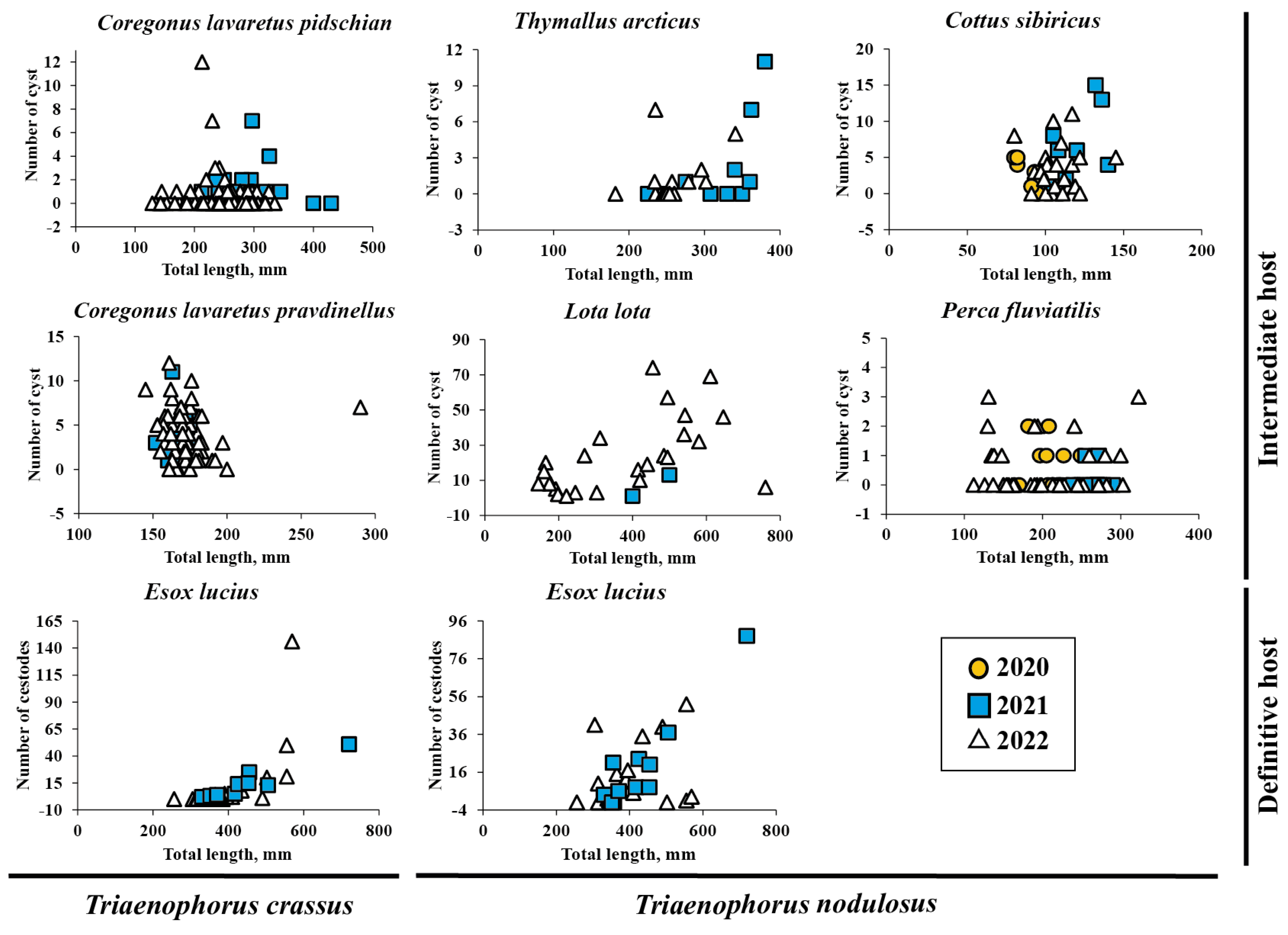
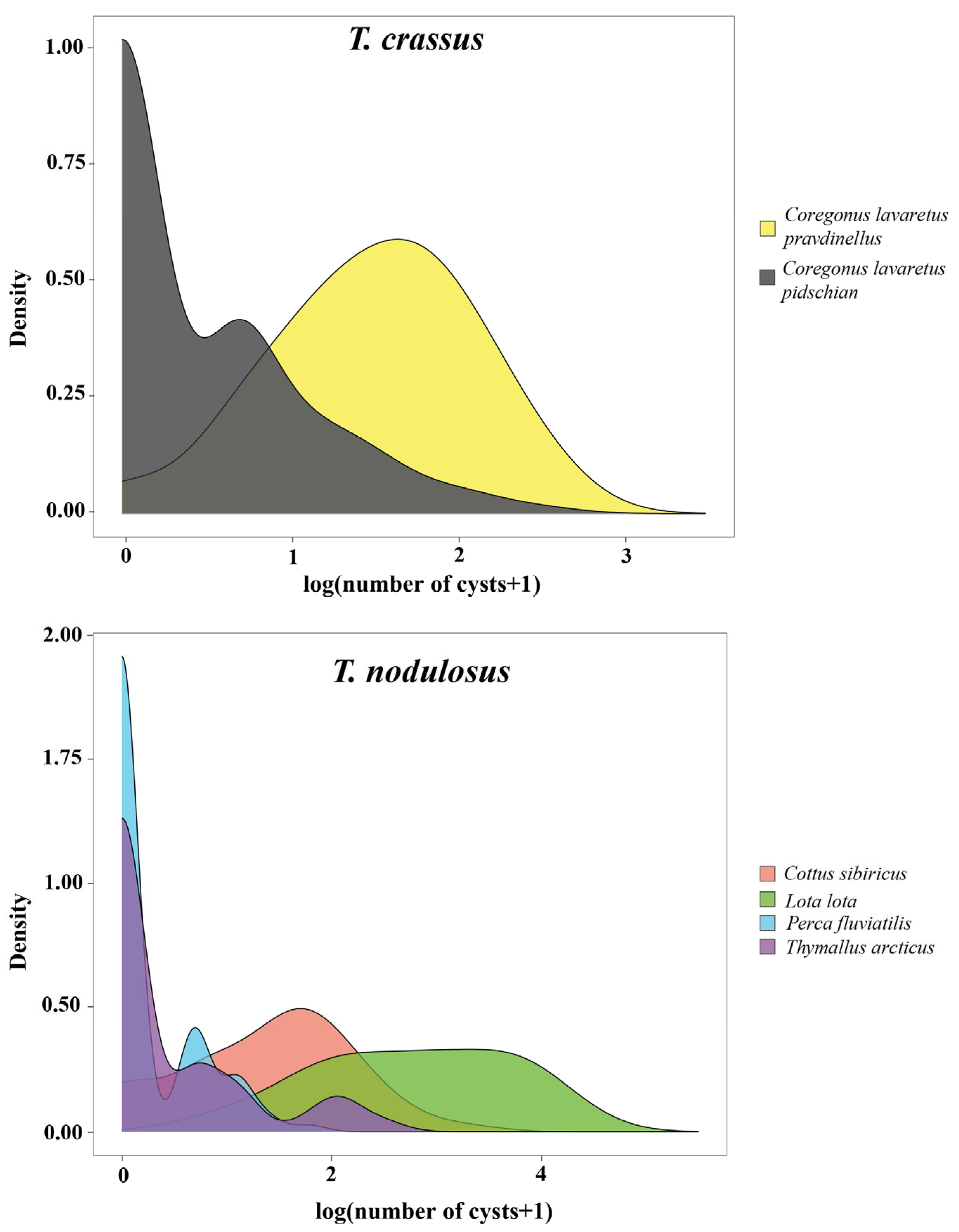
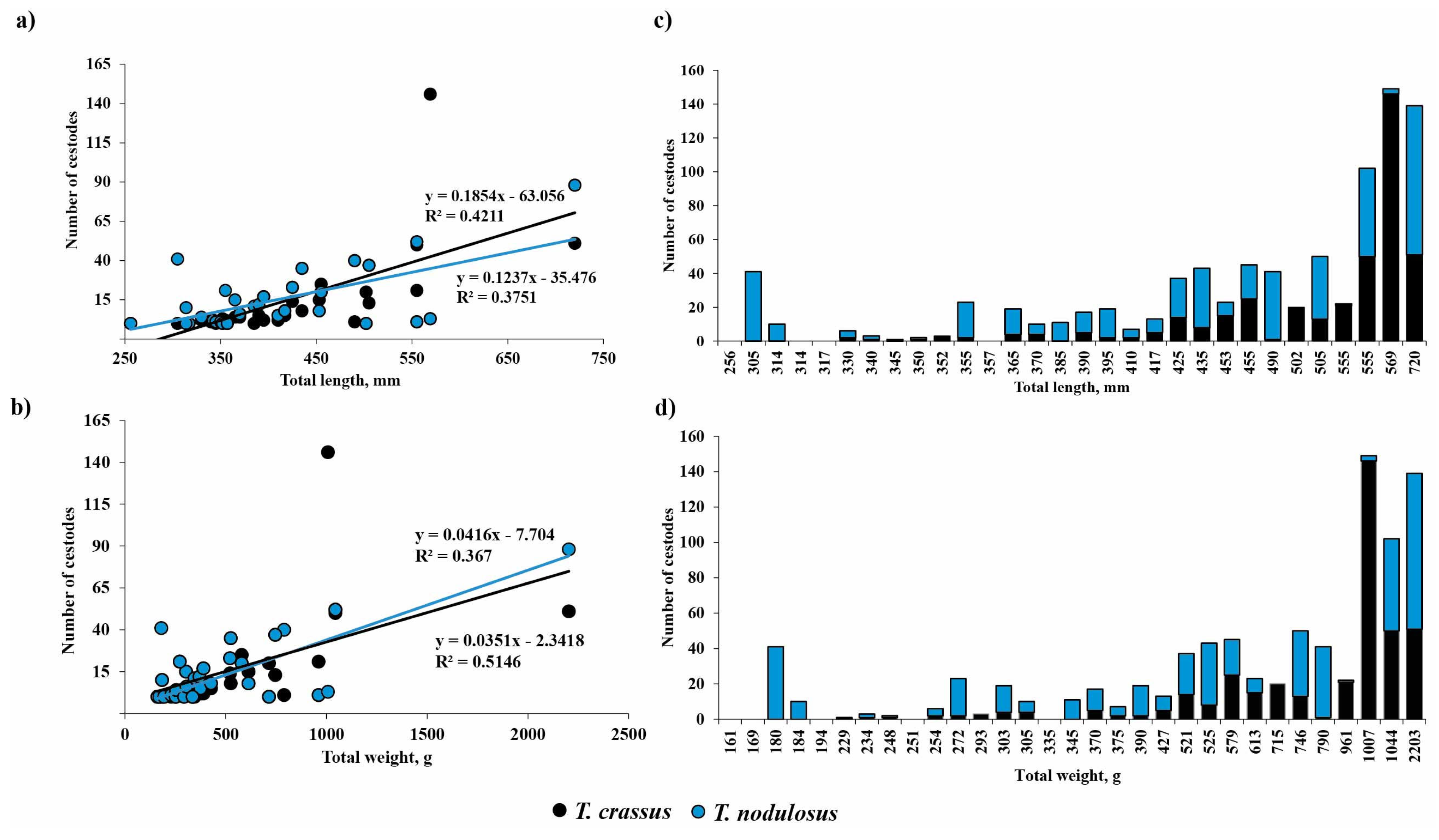
 ) and their relationship with fish total body weight (
) and their relationship with fish total body weight ( ). (a) Weight of all cysts or adult worms, g; (b) weight of single cyst or adult worm, g; (c) weight of all cysts or adult worms from total body weight, and weight of liver of fish, %; (d) weight of single cyst or adult worm from total body weight, and weight of liver of fish, %. Boxplots represent mean (crosses) with outliers (empty circles). The percent on the top of graph (c,d) indicates the weight of parasites.
). (a) Weight of all cysts or adult worms, g; (b) weight of single cyst or adult worm, g; (c) weight of all cysts or adult worms from total body weight, and weight of liver of fish, %; (d) weight of single cyst or adult worm from total body weight, and weight of liver of fish, %. Boxplots represent mean (crosses) with outliers (empty circles). The percent on the top of graph (c,d) indicates the weight of parasites.
 ) and their relationship with fish total body weight (
) and their relationship with fish total body weight ( ). (a) Weight of all cysts or adult worms, g; (b) weight of single cyst or adult worm, g; (c) weight of all cysts or adult worms from total body weight, and weight of liver of fish, %; (d) weight of single cyst or adult worm from total body weight, and weight of liver of fish, %. Boxplots represent mean (crosses) with outliers (empty circles). The percent on the top of graph (c,d) indicates the weight of parasites.
). (a) Weight of all cysts or adult worms, g; (b) weight of single cyst or adult worm, g; (c) weight of all cysts or adult worms from total body weight, and weight of liver of fish, %; (d) weight of single cyst or adult worm from total body weight, and weight of liver of fish, %. Boxplots represent mean (crosses) with outliers (empty circles). The percent on the top of graph (c,d) indicates the weight of parasites.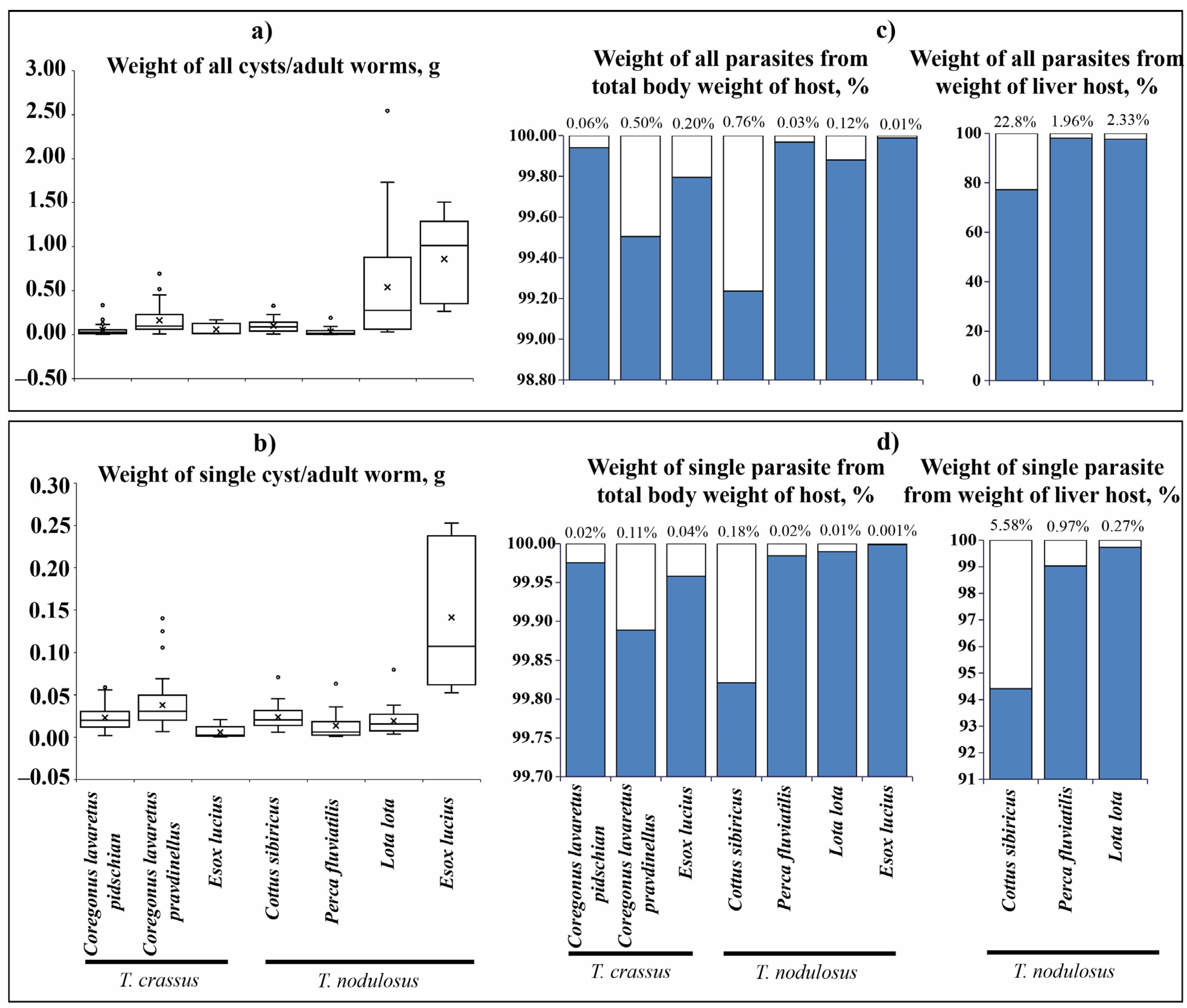

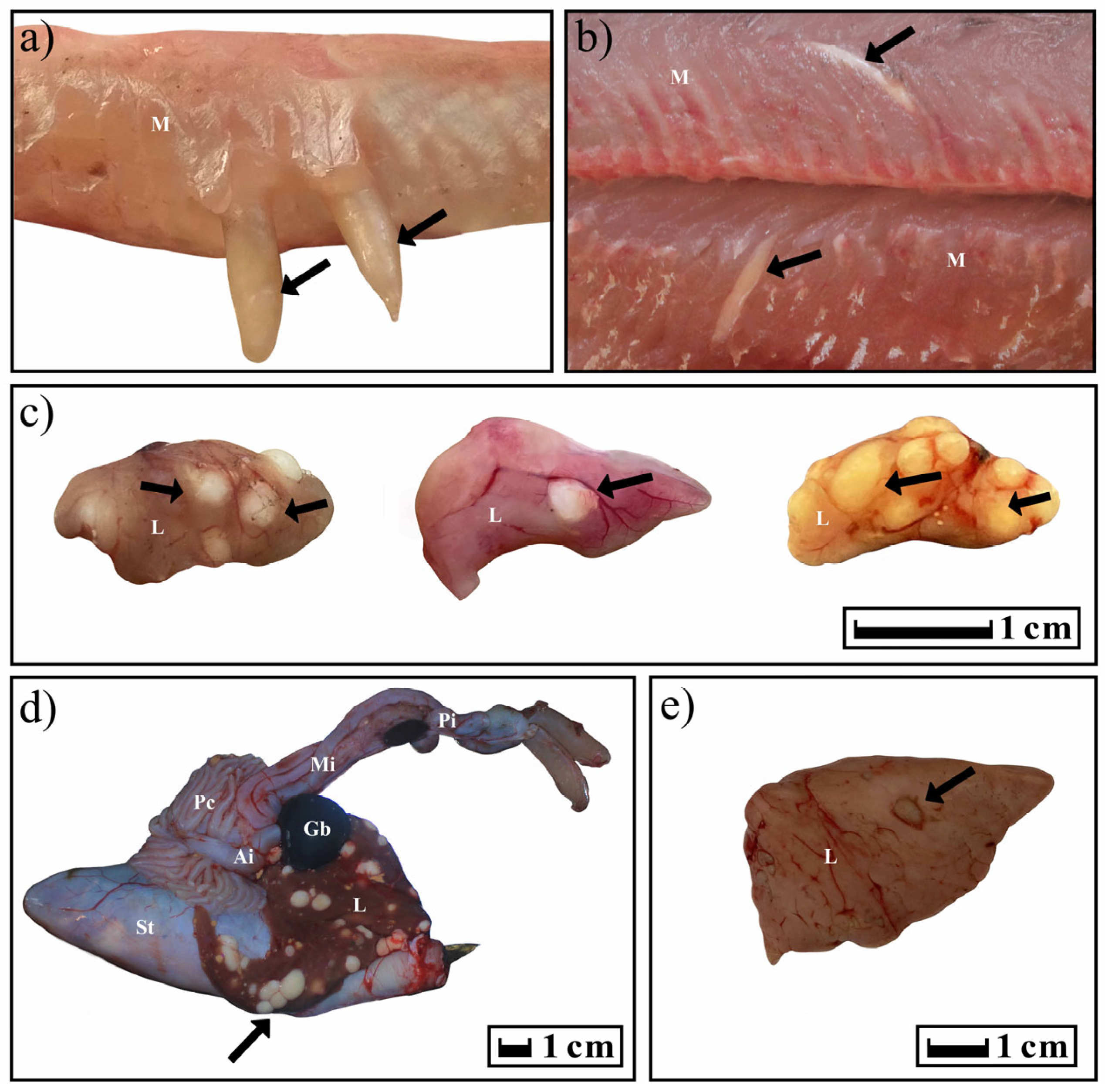

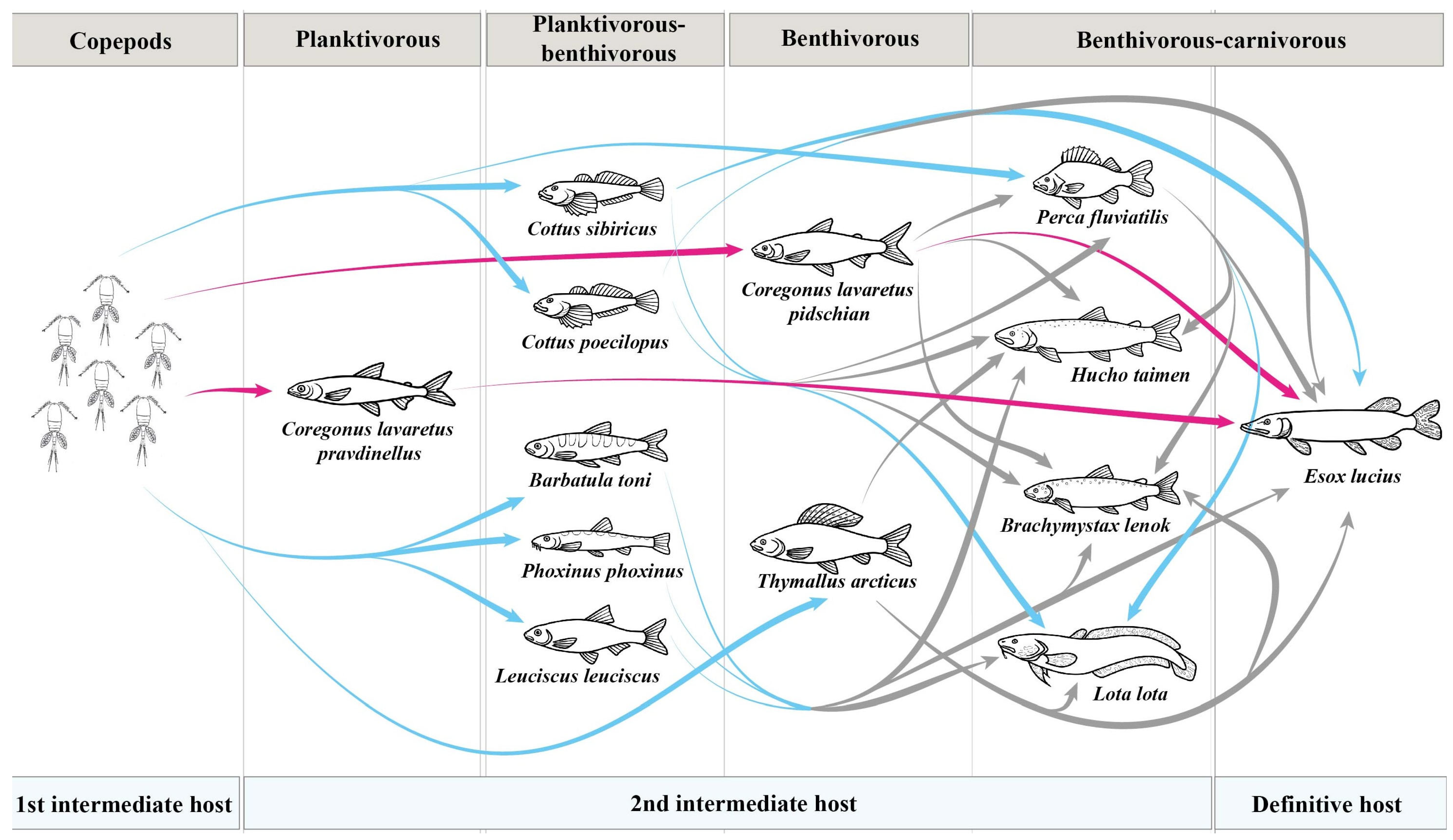
| Fish Species | Fish Diet in Teletskoye Lake | Stage in Fish | Localization | Parasite Species | Year | Number Fish Examined | BW, g (Mean ± SE) | EBW, g (Mean ± SE) | TL, mm (Mean ± SE) | Sex Ratio (F:M) * |
|---|---|---|---|---|---|---|---|---|---|---|
| Coregonus lavaretus pidschian 1 | Chironomids (larvae), gammarids, mollusks (gastropoda) | Larvae | Muscles | T. crassus | 2021 | 41 | 176.3 ± 17.0 | - | 266.6 ± 7.6 | 1.7:1 |
| 2022 | 99 | 160.6 ± 10.6 | 140.3 ± 9.4 | 247.9 ± 5.0 | 1:2.3 | |||||
| Coregonus lavaretus pravdinellus 2 | Zooplankton | Larvae | Muscles | T. crassus | 2021 | 21 | 31.0 ± 1.3 | 25.5 ± 1.5 | 167.5 ± 1.7 | 1:1.3 |
| 2022 | 68 | 33.8 ± 0.8 | 27.5 ± 0.8 | 172.5 ± 2.2 | 1:4.7 | |||||
| Cottus sibiricus 3 | Filamentous algae, zooplankton, chironomids (larvae), gammarids, mollusks (gastropoda), Trichoptera (larvae), detritus | Larvae | Liver | T. nodulosus | 2019 | 4 | - | - | - | - |
| 2020 | 12 | 12.0 ± 1.1 | 11.9 ± 1.2 | 92.8 ± 3.1 | 1:2 | |||||
| 2021 | 11 | 20.4 ± 3.1 | - | 117.8 ± 4.2 | 0:1 | |||||
| 2022 | 28 | 14.4 ± 1.2 | 11.9 ± 0.9 | 108.0 ± 2.6 | 1:1.2 | |||||
| Perca fluviatilis 4 | Chironomids (larvae), gammarids, fish fry | Larvae | Liver | T. nodulosus | 2019 | 20 | - | - | - | - |
| 2020 | 22 | 138.4 ± 15.0 | 119.2 ± 12.9 | 216.7 ± 7.7 | 1:4.3 | |||||
| 2021 | 14 | 257.4 ± 13.7 | 222.8 ± 9.9 | 264.5 ± 3.4 | 12:1 | |||||
| 2022 | 46 | 117.9 ± 16.1 | 100.6 ± 12.2 | 195.4 ± 8.3 | 1.2:1 | |||||
| Thymallus arcticus 5 | Filamentous algae, chironomids (larvae), gammarids, mollusks (gastropoda), Trichoptera (larvae) | Larvae | Liver | T. nodulosus | 2021 | 24 | 328.7 ± 40.8 | 312.3 ± 40.8 | 306.9 ± 11.1 | 1.4:1 |
| 2022 | 23 | 160.0 ± 15.7 | 143.0 ± 13.9 | 250.7 ± 7.4 | 1.1:1 | |||||
| Lota lota 6 | Filamentous algae, chironomids (larvae), gammarids, mollusks (gastropoda), fish fry | Larvae | Liver | T. nodulosus | 2021 | 5 | 804.3 ± 356.6 | 678.7 ± 314.0 | 487.3 ± 47.2 | 2:1 |
| 2022 | 30 | 728.0 ± 175.1 | 603.3 ± 143.7 | 377.9 ± 36.0 | 1.8:1 | |||||
| Phoxinus phoxinus 7 | Filamentous algae, mollusks (gastropoda), zooplankton, larvae of insects | Larvae | Liver | T. nodulosus | 2022 | 8 | 1.39 ± 0.07 | - | 57.88 ± 0.81 | - |
| Esox lucius 8 | Fish | Adult | Intestine | T. crassus, T. nodulosus | 2021 | 17 | 467.3 ± 76.1 | 410.0 ± 64.3 | 405.7 ± 23.7 | 1:2.5 |
| 2022 | 14 | 519.7 ± 141.8 | 474.4 ± 124.3 | 418.0 ± 29.2 |
| Fish Species | Parasite | Year | Prevalence, % | Intensity (Mean ± SE) | Abundance (Mean ± SE) | Total Number of Fish | Number of Healthy Fish | Number of Fish Infected | Number of Parasites |
|---|---|---|---|---|---|---|---|---|---|
| Cor. l. pidschian | T. crassus | 2021 | 41.5 | 1.8 ± 0.4 | 0.8 ± 0.2 | 41 | 24 | 17 | 31 |
| 2022 | 27.3 | 1.8 ± 0.5 | 0.5 ± 0.1 | 99 | 72 | 27 | 50 | ||
| 2021–2022 | 31.4 | 1.8 ± 0.2 | 0.6 ± 0.1 | 140 | 96 | 44 | 81 | ||
| Cor. l. pravdinellus | 2021 | 100.0 | 5.0 ± 0.8 | 5.0 ± 0.8 | 21 | 0 | 21 | 105 | |
| 2022 | 89.7 | 4.5 ± 0.5 | 4.0 ± 0.5 | 68 | 7 | 61 | 274 | ||
| 2021–2022 | 92.1 | 4.6 ± 0.4 | 4.3 ± 0.4 | 89 | 7 | 82 | 379 | ||
| E. lucius | 2021 | 64.7 | 23.6 ± 6.3 | 15.3 ± 8.7 | 17 | 6 | 11 | 260 | |
| 2022 | 78.6 | 12.3 ± 5.6 | 9.6 ± 3.8 | 18 | 7 | 11 | 135 | ||
| 2021–2022 | 71.0 | 17.9 ± 5.7 | 12.7 ± 5.0 | 35 | 13 | 22 | 395 | ||
| Cot. sibiricus | T. nodulosus | 2019 | 100.0 | 5.0 ± 1.5 | 5.0 ± 1.5 | 4 | 0 | 4 | 20 |
| 2020 | 66.7 | 3.6 ± 0.8 | 2.4 ± 0.7 | 12 | 4 | 8 | 29 | ||
| 2021 | 100.0 | 8.0 ± 2.3 | 8.0 ± 2.3 | 11 | 0 | 11 | 88 | ||
| 2022 | 78.6 | 4.2 ± 0.6 | 3.3 ± 0.6 | 28 | 6 | 22 | 93 | ||
| 2019–2022 | 81.8 | 5.1 ± 0.7 | 4.2 ± 0.6 | 55 | 10 | 45 | 230 | ||
| Pe. fluviatilis | 2019 | 20.0 | 1.2 ± 0.2 | 0.2 ± 0.1 | 20 | 16 | 4 | 5 | |
| 2020 | 27.3 | 1.3 ± 0.2 | 0.4 ± 0.1 | 22 | 16 | 6 | 8 | ||
| 2021 | 21.4 | 1.0 ± 0.0 | 0.2 ± 0.1 | 14 | 11 | 3 | 3 | ||
| 2022 | 26.1 | 1.7 ± 0.2 | 0.5 ± 0.1 | 46 | 34 | 12 | 21 | ||
| 2019–2022 | 24.5 | 1.5 ± 0.1 | 0.4 ± 0.1 | 102 | 77 | 25 | 37 | ||
| Th. arcticus | 2021 | 33.3 | 4.1 ± 1.3 | 1.4 ± 0.6 | 24 | 16 | 8 | 33 | |
| 2022 | 30.4 | 2.6 ± 0.3 | 0.8 ± 0.1 | 23 | 16 | 7 | 18 | ||
| 2021–2022 | 31.9 | 3.4 ± 1.1 | 1.1 ± 0.3 | 47 | 32 | 15 | 51 | ||
| L. lota | 2021 | 100.0 | 7.4 ± 2.2 | 7.4 ± 2.2 | 5 | 0 | 5 | 37 | |
| 2022 | 100.0 | 23.5 ± 3.7 | 23.5 ± 3.7 | 30 | 0 | 30 | 706 | ||
| 2021–2022 | 100.0 | 21.2 ± 3.3 | 21.2 ± 3.3 | 35 | 0 | 35 | 743 | ||
| E. lucius | 2021 | 76.5 | 18.8 ± 4.8 | 14.3 ± 4.1 | 17 | 4 | 13 | 244 | |
| 2022 | 78.6 | 19.7 ± 6.7 | 15.5 ± 6.3 | 18 | 7 | 11 | 217 | ||
| 2021–2022 | 77.4 | 19.2 ± 3.7 | 14.9 ± 3.6 | 35 | 11 | 24 | 461 |
| Species | Parasite | Mean Weight of all Cysts and Number of Cysts | Average Individual Weight of Cyst and Number of Cyst | ||
|---|---|---|---|---|---|
| Spearman’s r | p-Value | Spearman’s r | p-Value | ||
| Cor. l. pravdinellus | T. crassus | 0.70 | <0.001 | −0.10 | 0.446 |
| Cor. l. pidschian | 0.70 | <0.001 | 0.19 | 0.261 | |
| Cot. sibiricus | T nodulosus | 0.78 | <0.001 | 0.01 | 0.972 |
| Pe. fluviatilis | 0.87 | <0.001 | 0.67 | 0.009 | |
| L. lota | 0.90 | <0.001 | 0.36 | 0.054 | |
| Forms/Species | Distribution | In the Middle of Epaxial and Hypaxial Muscles | Epaxial Muscles | Hypaxial Muscles | Epaxial Muscles | Hypaxial Muscles | Epaxial Muscles | Hypaxial Muscles | Total |
|---|---|---|---|---|---|---|---|---|---|
| From Head to Dorsal Fin (I) | Between Dorsal Fin and Adipose Fin (II) | Tail Muscles (III) | |||||||
| “Dwarf” Cor. l. pravdinellus | Left side of body | ||||||||
| Number of cysts | 3 | 15 | 2 | 30 | 20 | 4 | 3 | 77 | |
| % | 3.90 | 19.48 | 2.60 | 38.96 | 25.97 | 5.19 | 3.90 | 100.00 | |
| Right side of body | |||||||||
| Number of cysts | 8 | 17 | 6 | 19 | 13 | 3 | 2 | 68 | |
| % | 11.76 | 25.00 | 8.82 | 27.94 | 19.12 | 4.41 | 2.94 | 100.00 | |
| Both sides of body | |||||||||
| Number of cysts | 11 | 32 | 8 | 49 | 33 | 7 | 5 | 145 | |
| % | 7.60 | 22.07 | 5.52 | 33.79 | 22.76 | 4.83 | 3.45 | 100.00 | |
| “Normal” Cor. l. pidschian | Left side of body | ||||||||
| Number of cysts | - | 2 | 0 | 1 | 2 | 0 | 0 | 5 | |
| % | - | 40.00 | 0.00 | 20.00 | 40.00 | 0.00 | 0.00 | 100.00 | |
| Right side of body | |||||||||
| Number of cysts | - | 4 | 6 | 3 | 5 | 0 | 0 | 18 | |
| % | - | 22.22 | 33.33 | 16.67 | 27.8 | 0.00 | 0.00 | 100.00 | |
| Both sides of body | |||||||||
| Number of cysts | - | 6 | 6 | 4 | 7 | 0 | 0 | 23 | |
| % | - | 26.09 | 26.09 | 17.39 | 30.43 | 0.00 | 0.00 | 100.00 | |
Disclaimer/Publisher’s Note: The statements, opinions and data contained in all publications are solely those of the individual author(s) and contributor(s) and not of MDPI and/or the editor(s). MDPI and/or the editor(s) disclaim responsibility for any injury to people or property resulting from any ideas, methods, instructions or products referred to in the content. |
© 2023 by the authors. Licensee MDPI, Basel, Switzerland. This article is an open access article distributed under the terms and conditions of the Creative Commons Attribution (CC BY) license (https://creativecommons.org/licenses/by/4.0/).
Share and Cite
Kashinskaya, E.N.; Vlasenko, P.G.; Kolmogorova, T.V.; Izotova, G.V.; Shokurova, A.V.; Romanenko, G.A.; Markevich, G.N.; Andree, K.B.; Solovyev, M.M. Metapopulation Structure of Two Species of Pikeworm (Triaenophorus, Cestoda) Parasitizing the Postglacial Fish Community in an Oligotrophic Lake. Animals 2023, 13, 3122. https://doi.org/10.3390/ani13193122
Kashinskaya EN, Vlasenko PG, Kolmogorova TV, Izotova GV, Shokurova AV, Romanenko GA, Markevich GN, Andree KB, Solovyev MM. Metapopulation Structure of Two Species of Pikeworm (Triaenophorus, Cestoda) Parasitizing the Postglacial Fish Community in an Oligotrophic Lake. Animals. 2023; 13(19):3122. https://doi.org/10.3390/ani13193122
Chicago/Turabian StyleKashinskaya, Elena N., Pavel G. Vlasenko, Tatyana V. Kolmogorova, Gelena V. Izotova, Anastasiya V. Shokurova, Georgy A. Romanenko, Grigorii N. Markevich, Karl B. Andree, and Mikhail M. Solovyev. 2023. "Metapopulation Structure of Two Species of Pikeworm (Triaenophorus, Cestoda) Parasitizing the Postglacial Fish Community in an Oligotrophic Lake" Animals 13, no. 19: 3122. https://doi.org/10.3390/ani13193122
APA StyleKashinskaya, E. N., Vlasenko, P. G., Kolmogorova, T. V., Izotova, G. V., Shokurova, A. V., Romanenko, G. A., Markevich, G. N., Andree, K. B., & Solovyev, M. M. (2023). Metapopulation Structure of Two Species of Pikeworm (Triaenophorus, Cestoda) Parasitizing the Postglacial Fish Community in an Oligotrophic Lake. Animals, 13(19), 3122. https://doi.org/10.3390/ani13193122







